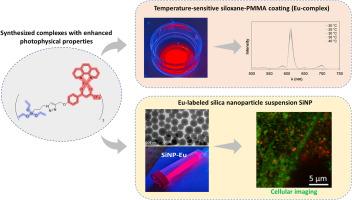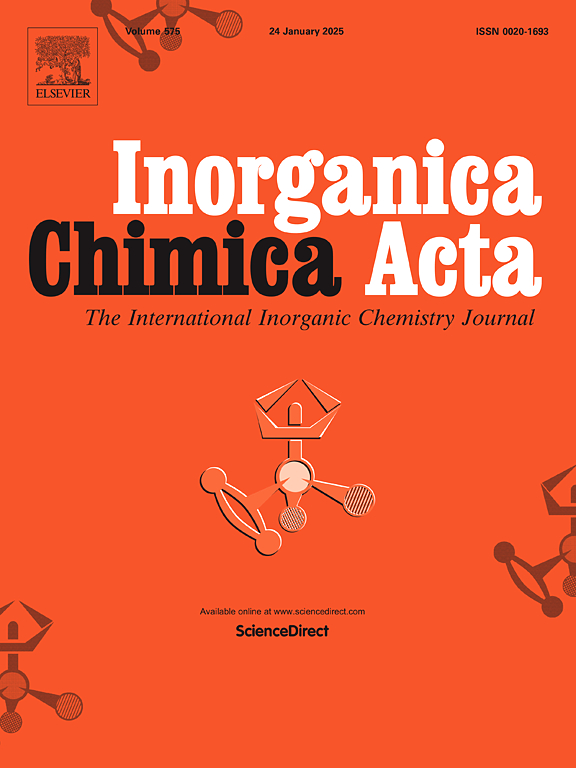硅烷修饰镧系配合物集成到杂化涂层和纳米颗粒:热敏应用和活细胞标记
IF 3.2
3区 化学
Q2 CHEMISTRY, INORGANIC & NUCLEAR
引用次数: 0
摘要
由于传统技术在空间分辨率和侵入性方面的限制,微纳米尺度的温度传感仍然是一个重大挑战。在这里,我们报告了基于新合成的铕(Eu)配合物集成到复合聚甲基丙烯酸甲酯-硅氧烷-二氧化硅(pmma -硅氧烷二氧化硅)基质中的发光,温度敏感涂层和纳米颗粒的发展。铕配合物被认为是三种镧系元素配合物中最有前途的候选物,通过铜催化叠氮化物-炔环加成与硅醚官能化,并成功地结合到玻璃表面和二氧化硅纳米颗粒的pmma -硅氧烷薄膜中。这些材料表现出强烈的热响应性、化学稳定性和高分辨率温度传感的适用性。此外,负载eu的二氧化硅纳米颗粒在活细胞共聚焦显微镜下显示出明显的荧光信号和多路复用能力,并被肺上皮细胞(LA-4细胞系)内化,突出了它们作为局部细胞内温度传感的生物成像探针的潜力。虽然在长时间激发下观察到一些光漂白,但材料表现出足够的化学和机械稳定性,使其具有发光温度传感和活细胞成像的前景。这些结果表明,所开发的铕基混合材料是用于高分辨率热传感和细胞成像的坚固、非侵入性发光探针。本文章由计算机程序翻译,如有差异,请以英文原文为准。

Silane-modified lanthanide complexes for integration into hybrid coatings and nanoparticles: thermal sensing applications and live cell labeling
Temperature sensing at the micro- and nanoscale remains a significant challenge due to the limitations of conventional techniques in spatial resolution and invasiveness. Here, we report the development of luminescent, temperature-sensitive coatings and nanoparticles based on a newly synthesized europium (Eu) complex integrated into a composite poly(methyl methacrylate)-siloxane-silica (PMMA-siloxane silica) matrix. The Eu complex, identified as the most promising candidate among three lanthanide complexes, was functionalized with silyl ethers via copper-catalyzed azide-alkyne cycloaddition and successfully incorporated into thin PMMA-siloxane silica films on glass surfaces and within silica nanoparticles. These materials exhibited strong thermal responsiveness, chemical stability, and suitability for high-resolution temperature sensing. Furthermore, Eu-loaded silica nanoparticles showed a distinct fluorescent signal and multiplexing capability in live-cell confocal microscopy and were internalized by lung epithelial cells (LA-4 cell line), highlighting their potential as bioimaging probes for localized intracellular temperature sensing. Although some photobleaching was observed under prolonged excitation, the materials demonstrated sufficient chemical and mechanical stability, making them promising for luminescent temperature sensing and live-cell imaging. These results establish the developed Eu-based hybrid materials as robust, non-invasive luminescent probes for high-resolution thermal sensing and cellular imaging.
求助全文
通过发布文献求助,成功后即可免费获取论文全文。
去求助
来源期刊

Inorganica Chimica Acta
化学-无机化学与核化学
CiteScore
6.00
自引率
3.60%
发文量
440
审稿时长
35 days
期刊介绍:
Inorganica Chimica Acta is an established international forum for all aspects of advanced Inorganic Chemistry. Original papers of high scientific level and interest are published in the form of Articles and Reviews.
Topics covered include:
• chemistry of the main group elements and the d- and f-block metals, including the synthesis, characterization and reactivity of coordination, organometallic, biomimetic, supramolecular coordination compounds, including associated computational studies;
• synthesis, physico-chemical properties, applications of molecule-based nano-scaled clusters and nanomaterials designed using the principles of coordination chemistry, as well as coordination polymers (CPs), metal-organic frameworks (MOFs), metal-organic polyhedra (MPOs);
• reaction mechanisms and physico-chemical investigations computational studies of metalloenzymes and their models;
• applications of inorganic compounds, metallodrugs and molecule-based materials.
Papers composed primarily of structural reports will typically not be considered for publication.
 求助内容:
求助内容: 应助结果提醒方式:
应助结果提醒方式:


